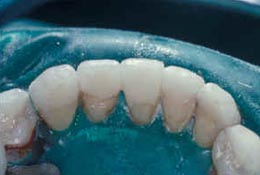Fiber Splinting System is a sample system used for all types of tooth splinting. This unique system offers a technology of resin impregnation and three choices of fiber strips. The different treated fiber configurations provide flexibility, in addition to substantial strength and ease of placement.
Almost all cases of Fibre Bond splinting are done without local anesthesia. A very thin groove is prepared on the lingual (inside) surface of the teeth, which are to be splinted. The groove does not usually extend into the dentine of the teeth, but stays within the enamel where the best bonding will be obtained. Placing rubber dam isolation in these cases will simplify the procedure for both the dentist and the patient and is recommended.

Missing tooth structure can be replaced through the use of gums or metal-ceramic crowns, and missing teeth can be replaced with any of a variety of fixed prostheses supported by teeth or implants. Porcelain-fused-to-metal substructures continue to be a mainstay of fixed prosthodontics, and polymethyl methacrylate (PMMA) polymer remains the material of choice for complete denture bases.
When compared to metals they offer many other advantages as well, including non-corrosiveness, translucency good bonding properties, and ease of repair. They also offer the potential for chair side and laboratory fabrication.
A fibre splint constructed in this way will form a reliable integrated structure which will give a potentially long term solution to the problem of mobile teeth. The fibres are transparent and unnoticeable when covered with the tooth colored composite filling material. It is therefore possible to create an aesthetically pleasing splint on the inside of the mobile teeth.
Fibre splinting is extremely unique form of denture restoring. If you are interested in finding a dentist splint with a superior track record who can help you enjoy the maximum benefits of dental procedures, then, it is Dr.Rajarajan.
(90).gif)















